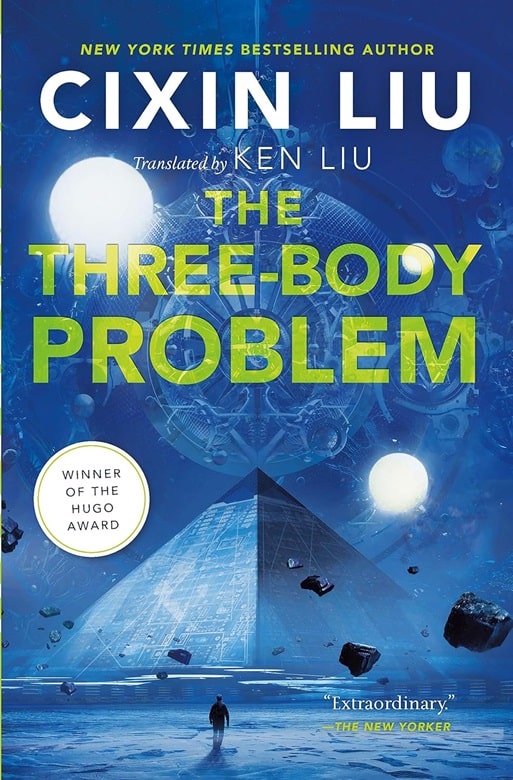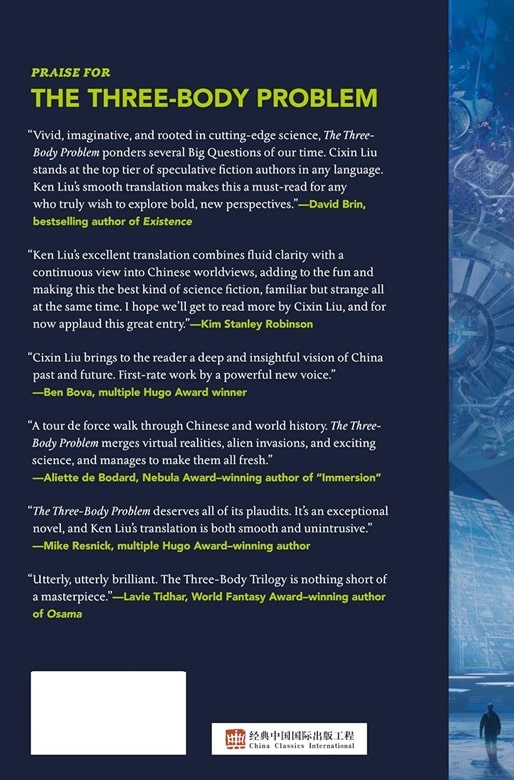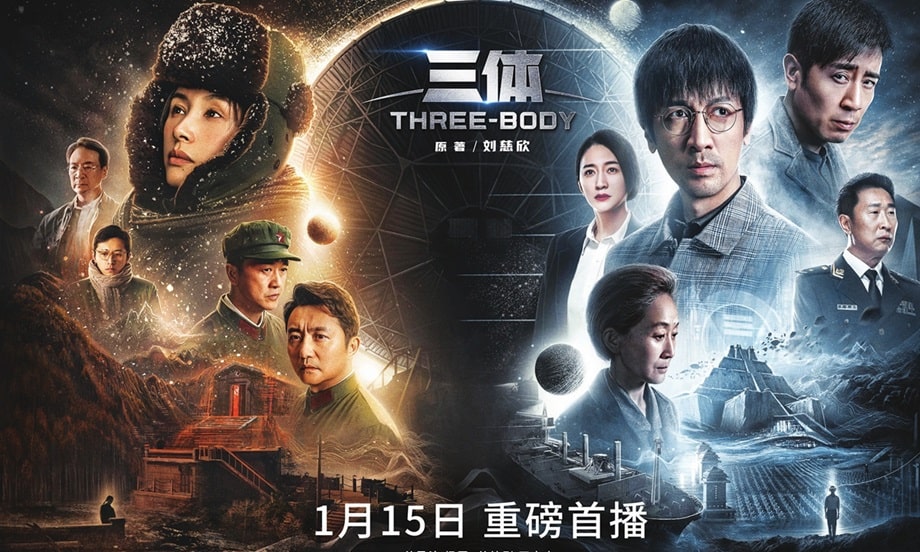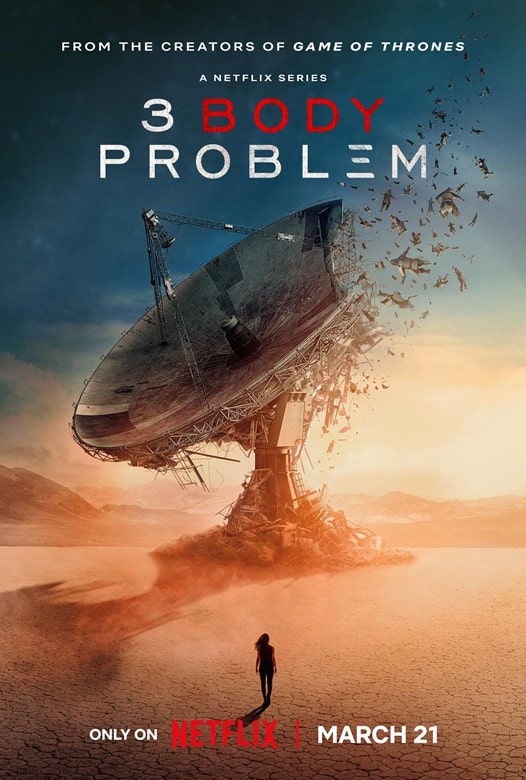My Three Problems with the Three-Body Problem
 |
 |
The Three-Body Problem (Tor Books, November 11, 2014). Cover by Stephan Martiniere
In the middle of trying to explain quantum mechanics to me, my physicist friend stopped in frustration and said, “This would all make a lot more sense if you understood math.”
Alas, I am one of those recovering English majors who never could wrap their heads around anything more basic than simple arithmetic (and not so good at even that). Intellectually, I can intuit how mathematical prowess unleashes secrets of the universe, while also presenting further paradoxes. (I kinda, sorta get Schrödinger’s cat, but not really.) But my eyes glaze over at the actual work of adding it all up. Which explains my barely passable grades back in college for courses such as Science for non-Science Majors.
So my first problem with Liu Cixin’s The Three-Body Problem is with exposition along the lines of basic introduction to physics such as this:
Energy produced by reaction within the solar core is initially in the form high-energy gamma rays. The radiation zone, the regions of the sun’s interior that surrounds the core, absorbs these high-energy photons and re-emits them at a a slightly lower energy level. After a long period of successive absorption and re-emission (a photon might take a thousand years to leave the sun), gamma rays become x-rays, extreme ultraviolet, ultraviolet, then eventually turn into visible light and other forms of radiation.
Okay, even I can understand this. Sort of. But it’s not exactly high literary prose.
And while Lui employs a virtual game as a way to explicate the three-body problem (an actual problem of orbital mechanics, and also a thematic notion of Stanislaw Lem’s Solaris with the literal addition of one more body to the problem) underlying the recruiting screening of an on-the-way invading aliens, it still gets bogged down in similar, “deep in the weeds” technical explications.
Then there is the whole notion of quantum entangled sophons that allow for intergalactic observation and communications. For example:
When both protons are made into sophons, they will, used in effect, create a mutual sensing system. More sophons can then form a mutual sensing-formation. This formation’s scale can be adjusted to any size, and can thus receive electromagnetic waves to sense the macro world at any frequency. Of course, the actual quantum effects necessary to create such a sophon formation are very complicated.
No doubt. Which, as my physics friend might say, makes a whole lot more sense if you actually understand the math.
Of course, that’s true of any hard science fiction novel where the centerpiece is rigorous attention to scientific detail. My physicist friend probably eats this kind of stuff up. The English major such as myself tends to start wishing the author might make his point and get on with it. I can read a fantasy novel and buy into all sorts of rituals and mythological details and not bother trying to make any sense of whether it actually works. Feel the same way about sophons. Okay there are things that allow aliens from light years away to talk to us. Enough said.
I loved The Lord of the Rings. Couldn’t care less about the linguistic etymology. Also loved Game of Thrones. Couldn’t care less about all the genealogy. I realize a lot of other people are really into that. But, for me, story and characters are what I’m looking for. The Lord of the Rings and Game of Thrones have that. The Three-Body Problem, not so much.
Which brings me to my second problem with The Three-Body Problem. The characters are as flat as the paper they are printed on. Again, this is not all that unusual for hard SF, particularly that from the Hugo Gernsback era, as well as the more philosophical-based speculation (e.g., Olaf Stapledon) that The Three-Body Problem also inhabits.
Three-Body (Tencent Video, 2023)
Of the three principal characters — Ye Wenjie, Wang Miao, and Shi Qiang — the most colorful and perhaps actually interesting is Shi. But even he is more of caricature of the cynical gumshoe working outside of the system. He smokes, he asks uncomfortable questions, he turns up out of nowhere at key moments.
But Philip Marlowe he is not. Ye is a sort of anti-hero, and Wang is the unlikely professor to solve the three-body problem, but they lack dimensionality. What Wang says about the death of Yang Dong (Ye’s daughter who commits suicide) could be said about any one of the various characters in the novel by substituting “novel” for “photographs” and “personality” for “her.”
Wang had always thought that his photographs lacked some kind of soul. Now he understood that they were missing her.
I only watched one episode of Three-Body, the Chinese tele series based on the book. It is a low-rent production, particularly in comparison to the recently released and much heralded Netflix version, and the dubbing probably doesn’t help the stiff acting.
3 Body Problem (Netflix, 2024)
But it does seem interested in character development, specifically Shi’s unconventional behavior. Interestingly, it starts with Shi’s investigations of the raft of physicist suicides rather than the brutal murder of Ye’s astrophysicist father for refusing to reject scientific principles deemed reactionary by the Red Guard.
While this scene is the opening of the English translation of the novel by Ken Lui, in the original Chinese version this was in the middle to avoid attracting attention by government censors (which says a lot about the attention span of government censors). Maybe that was also the actual intent of Three-Body, or perhaps just a way to wrangle the novel’s non-linear narrative, or both.
The Netflix series does start with the murder of Ye’s father, as well as a more straightforward narrative. Most significantly, though, and where it most deviates from the source, is relocating the central setting from China to Oxford, England, introducing several new characters to provide more tension and humor.
Eiza González as Auggie Salazar in 3 Body Problem (Netflix)
Given that show runners Dave Benioff and D.B. Weiss lost their footing during the last few seasons of Game of Thrones when they no longer had the actual books to work from, give credit where credit is due. It is a successful adaptation, though branching off from the novel in many ways, that tries to bring some life to the characters. Though perhaps the writers saw too many episodes of Friends.
My third problem with The Three-Body Problem is me. The book won a Hugo for best novel, and was nominated as well for a Nebula and a host of other awards. Critical acclaim is virtually universal. It put Chinese science fiction on the proverbial map.
So the problem must be with me. I can’t recall a novel that posits an alien invasion that’s going to take 400 years to happen (and I haven’t read the remaining two books in the Remembrance of Earth’s Past trilogy to see how that works out), which is an interesting take on a core SF trope of “aliens amongst us.”
There’s also the various themes related to blind political loyalty (to both the government and alien invaders), the existence (or not) of God, the terror of recognizing everything you held true is not, the existential dilemma of just how small and insignificant human beings are in the context of an expanding universe with an observable diameter of 93 billion light years (how they figure this out, I guess you have to understand math).
Although Lui has apparently commented that people shouldn’t read that much into it, I think we can file that under Herman Melville saying Moby Dick is just about a whale.
So there’s a lot to think about in The Three-Body Problem. I just wish there was a little less physics. And one or two characters I could be interested in.
David Soyka is one of the founding bloggers at Black Gate. He’s written over 200 articles for us since 2008. His most recent was a review of The Strange by Nathan Ballingrud.



My problem with the Three Body Problem is that damn nanofiber.
For all the author’s musings on physics, it’s known that the maximum theoretical strength of any fiber is about 30-40GPa — not more than 5x stronger than today’s best carbon fibers, e.g. Toray T1200.
The upper-bound is known because the strength of a pristine, perfect fiber approximates the strength of its atomic bonds. (T1200 falls short of its theoretical strength because it’s not quite perfect; its strength is reduced by defects.)
And yet a 40GPa fiber would be a dozen orders of magnitude too weak to do what’s depicted in the book/show. That’s a job for a laser, not a fiber. (A laser the likes of which does not yet exist — but at least it’s physically plausible, unlike the fiber.) Liu was a little bit too clever by half.
Don’t even get me started on the show’s “we can’t send troops, it’ll be a bloodbath!”
The science in The Three Body Problem (book, not series, which I haven’t watched) is about as “Hard” as your typical Science Wonder Stories piece from 1932. The more math you know, probably the less you like it. That said, in some ways that can be a virtue.
I did read the first book of the trilogy and thought it kind of interesting, but if anything it has diminished for me over time. The issues you mention — the flat prose, the flat characters, the flat devotion to whatever your authoritarian government demands — seem in retrospect less worth looking past.
I read The Three Body Problem a few years ago, and I have to say it struck me as having a 1930s, pre-Campbell feel, in two ways: the flatness of the characterization, and the reliance on direct exposition, with none of the techniques that Campbell made commonplace in American SF. It’s not an era I’m nostalgic for, so the book didn’t really speak to me.
WHS and RH– This 1930s sci-fi aspect is kind of interesting. As I’ve read scattered works translated into English over the years, it’s struck me that the older works that have been translated multiple times are richer, and the once-translated new works are flatter. I always concluded that this was a translation and linguistic sensitivity problem. BUT now you’re making me wonder if it’s a problem with what’s being translated out of English.
English-language literature is by no means the be all, end all arena for science fiction, but as it branches over so many geographies and so many cultures, it is considered probably the fastest-moving. It adopts new techniques and shifts with cultural norms almost instantaneously. Whereas, translation to another language often takes as long as or longer than writing a book, and even longer in cultures where publication is complicated by a further layer of review for comportment with sociopolitical values. So… is it possible that translated-from-English 1930s fiction is the government-accepted state of the science fictional art, and what we’re getting translated back into English is reflective of that?
Eh. Spitballing. Haven’t investigated this at all.
No interest in the book or series. The very premise sounds like a 50s alien invasion movie crossed with an unnecessarily convoluted (and just idiotic) low mileage “high concept.” I’m also probably even worse than you at math and likewise only care about a good story with well-written characters. The Netflix show seems like a terrible waste of money for something so junky looking. Give me “War of the Worlds” any day.
Damn! Being a cave dweller, I never read the book and just heard about the show (needless to say, my social credit score is shockingly low). Just a couple of days ago I was considering watching it, but now I think I’ll take a pass; thanks for keeping me from wasting my time.
As an interesting sidebar, there’s this article in today’s New York Times about the murder of a Chinese billionaire who bought the rights to the the Three-Body Problem.
https://www.nytimes.com/2024/04/01/world/asia/china-three-body-problem-murder.html
[…] My latest Blackgate post is My Three Problems with The Three Body Problem. […]
And, for further discussion (promise this will be the last addition), see this: https://www.nytimes.com/2024/04/08/business/3-body-problem-china-reaction.html